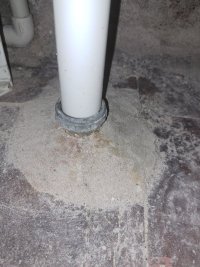Redrabbitdownthehole
Clueless Guru
I recently replaced Laundry tub and faucet in my basement. I also had to replace the old metal 1-1/2" s-trap drain (leaking) and was thinking about adding a washer standpipe instead of having it drain into the tub. The house was built in the 1950’s and the drain pipe opening that goes into the basement floor is 1-1/2” wide. Not exactly sure what the code is in PA, but I think it requires standpipe to be 2” now. I have no problem adding a 2” standpipe, but it will be drained down to a 1-1/2” pipe that goes underground (to the main line I assume). Does that work or having 1-1/2” drain pipe defeats the whole cause of the 2” standpipe? If it doesn’t matter should I just use 1-1/2” standpipe and not worry about the reducer fittings?
The Laundry tray sit next to the washer so I was going to use a sanitary tee to connect the standpipe (30" or 36" whatever length is above the tub and washer) and the sink drain together before going through a p-trap. And use another sanitary tee to connect the drain and air admittance valve (this is allow in PA…I think). Can I have the AAV under the sink or does it have to be above the sink and above the standpipe?
Also any opinion on Oatey Fusion single step (good or bad)? I was planning on buying this since it seems more forgiving (longer cure time more room to work with) and easier process (no primer). Thanks for the help.
The Laundry tray sit next to the washer so I was going to use a sanitary tee to connect the standpipe (30" or 36" whatever length is above the tub and washer) and the sink drain together before going through a p-trap. And use another sanitary tee to connect the drain and air admittance valve (this is allow in PA…I think). Can I have the AAV under the sink or does it have to be above the sink and above the standpipe?
Also any opinion on Oatey Fusion single step (good or bad)? I was planning on buying this since it seems more forgiving (longer cure time more room to work with) and easier process (no primer). Thanks for the help.

